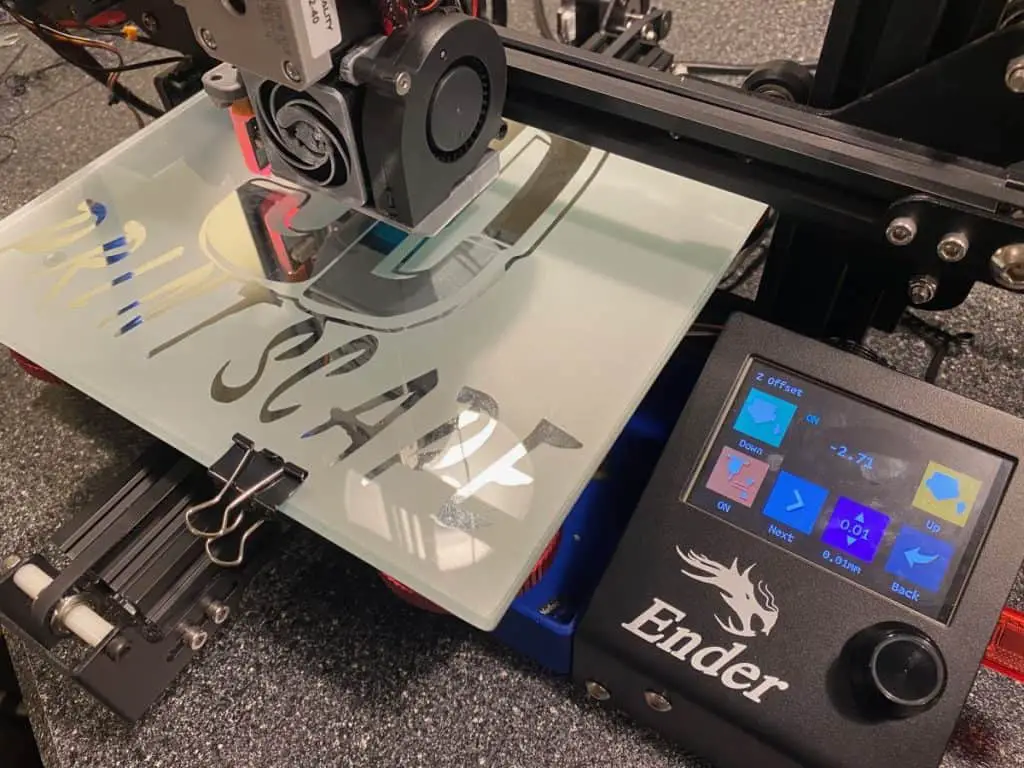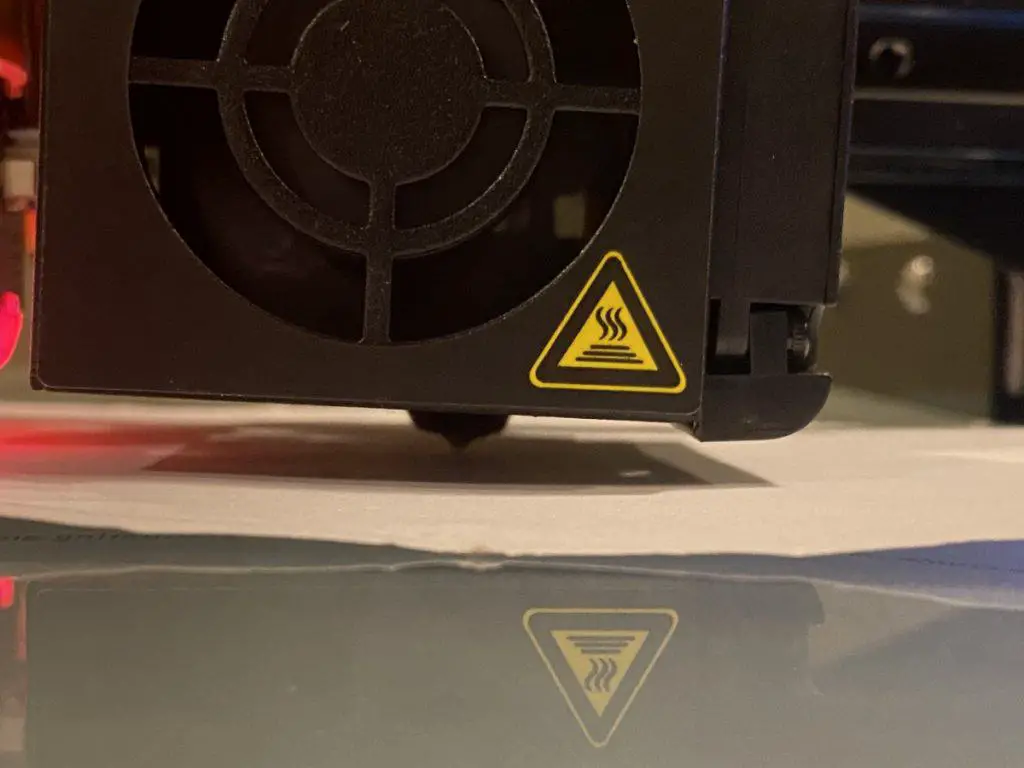I’ve been 3d printing and tinkering with 3d printers for a while now, and a question that new people to 3d printing often ask is whether a 3d printer has to be on a level surface. I thought I’d put together this article to explain the answer.
So, does a 3d printer have to be on a level surface? As a general rule, a 3d printer should be on a level surface. You can check this by using a carpenter’s level. This will make it easier to level the build plate and help prevent the printer from wobbling.
You’ll also want to level your bed, which is separate from making sure your 3d printer is on a level surface.
Below, I’ll explain everything you need to know about how to make the surface underneath your 3d printer level, how to level your 3d printer bed, and why it’s important.

How to Check That Your 3d Printer Is On a Level Surface
You want to measure whether your 3d printer is on a level surface or not by placing the level on the top or sides of your 3d printer and not on the 3d printing plate.
The plate is normally way off out of the box. And if you get your 3d printer level, by measuring the plate, it won’t be accurate. Also, you should use your level on the desk or table that your 3d printer is on to see if it’s flat.
To do that, place the level on your desk or table where the 3d printer will sit, and then move the level around, and rotate the level horizontally and vertically.
There is a small bubble in the middle of a level, that will move outside the lines, and will show you what corner’s are a bit too high or a bit too low. While moving the level around observe the bubble on your level to see if it goes outside the guidelines.
Here’s a really good guide by WikiHow which shows how to read the different kinds of levels such as a carpenter’s level, and a torpedo level.
There are a few common issues that can make your 3d printer not level. These are:
- The desk or table isn’t level
- One of the 3d printer legs is a bit longer than the other – quite rare
- Your 3d printer bed isn’t level yet
You want to level your 3d printer bed after you’ve levelled the surface it sits on, as well as your 3d printer. So, don’t worry about whether the 3d printer bed isn’t perfectly flat for now.
If you identify any parts of your table or desk that aren’t level, you can add a spacer made of Blue Tak, thin cardboard or small pieces of paper like post it notes under one of the table legs. This will slightly raise one side of the table slightly and even it out.
Then you’ll want to re-check it again using your level until you’ve got it as level as it can be. And repeat as necessary until your table is as level as it can be.
A table or desk can be designed so that it’s very solid, or it can be weak and have wonky legs.
If you have one of these kinds of desks, you’re better to put it on a stronger and more heavy-duty desk. If you don’t have a table or desk that works well for your 3d printer yet, you can put it on the floor.
However, you shouldn’t plan on keeping on the floor, because you’ll typically get more dust, and it’s easy to trip over and damage it or stub your toe!
Does a 3D Printer Need to Be Level?
A 3d printer extrudes hot filament that is soft until it goes hard, and if your 3d printer is on a slight angle, the hot filament will flow to the lower side. This will make your prints all wonky.
But, do you need to level your 3d printer? Here’s what you need to know…
A 3d printer should be as level as possible. Out of the box, your 3d printer should be level, and you’ll only need to fine-tune your 3d printer bed to get it perfectly flat. This is a bit of a process and involves testing each of the corners using a piece of paper and adjusting the knobs.

Tables and desks can be slightly imperfect and it’s important to note that you generally can’t get it 100% level. But, your 3d printer will still print fine even if it isn’t perfectly level.
But, you get the most precise prints when your 3d printer is as level as possible. You might find that your table is perfectly level, but the bed on your 3d printer isn’t level.
This can be because one of the legs on your 3d printer is slightly longer than the others. Or, one of the legs is sitting in a part of the desk or table that isn’t perfectly flat. You can move your 3d printer around on your table, to see if that makes it more level.
And also put spacers underneath the feet of your 3d printer to level it out. After you’ve got your desk or table level, and your 3d printer level you’ll want to level your 3d printer bed.
This makes the space in between your printer nozzle and the bed is the same all the way around. It’s a little bit tricky but not very hard at all. Here’s how to manually level your 3d printer bed
How Do You Manually Level a 3d Printer Bed?
When you first get your 3d printer you likely have a large gap between your printer nozzle and the bed and the bed typically isn’t level. There are two things you want to do when you’re leveling your 3d printer bed.
These are 1) making the bed perfectly level and 2) adjusting the height of the bed so that the nozzle is close enough to print correctly.
The easiest way to do this is to use a piece of paper, and adjust the gauges underneath the bed to bring it closer to the bed. This will both completely level your 3d printer bed, and bring the bed to the right height.
The aim is to lift the bed enough so that you just feel a bit of friction on the paper. As the nozzle pinches the paper against the bed.
You want to do this procedure on each of the 4 corners. And then once you’ve adjusted each corner so it’s perfect, you’ll want to recheck it. When you change the height of one corner it affects the others, and you’ll need to adjust the height slightly on each corner again once they’re about right.
According to All3dp.com you also want to clean your 3d print plate using rubbing alcohol or a mild soap to remove any dirt that could affect your measurement.
Here’s a quick video that shows how to do it:
This will take care of making your bed perfectly level, and adjust the height of your bed so it’s the right distance from the nozzle. You can then do a test print to see that it’s all working correctly before printing a design.
How Often Should You Level a 3d Printer Bed?
Leveling your 3d printer bed takes around 5 to 10 minutes once you’ve done it a few times. But, how often should you level your 3d printer bed?
Generally, you’ll only need to level your 3d printer bed once OR you’ll need to level it every few weeks. Each 3d printer is slightly different and you’ll want to level your bed when you notice something is off, and prior to an important print.
You can tell there’s something off with how flat your 3d printer or your 3d printer bed is, when your prints don’t look quite right. There can be a range of issues that can cause a bad print such as the filament not getting hot enough, or the extruder not pumping out the filament properly.
But, checking that your bed is level is a good first step. You may have bumped your desk which could have moved your 3d printer bed. Or the cogs you use to adjust your bed height might have moved slightly over time.
The good news is it’s very quick and easy to level your printer bed again, and double-check that your 3d printer is on a level surface.
Related Questions
- How do I get started with a 3d printer? – I wrote a guide that covers this entire process from start to finish and included site that you can download free 3d objects from. You can read that guide here, “How to Print a File from Thingiverse (The Easy Way!)”.
- Do I need a powerful computer? – The short answer is no, any relatively modern computer will work just fine. I wrote an article that covers this topic in more detail that you can read here “What Computer Do I Need for a 3D Printer?“.
- What if my build plate is warped? – If you ended up getting a warped bed, which unfortunately many people do, you have a couple of options. The first one would be to switch to a glass build plate; this will help level things out. Option two would be to add an automatic bed level kit, like the BLTouch to the printer. Here is an article that covers that process on an Ender 3, “Guide to Install a BLTOUCH on a Creality 32-bit Mainboard”.
Related Articles
- How to Print a File from Thingiverse (The Easy Way!)
- What Is 3D Printer Resolution?
- What Computer Do I Need for a 3D Printer?
- Cura Profiles
Recap
A 3d printer should be placed on a level surface if possible to make it easier to level the bed and prevent the printer from wobbling. If the surface is a little off level, you can put a foam pad between the surface and printer to help level things out. If the surface is very uneven, I would recommend looking for another place to put the 3d printer.
Make sure you check out our YouTube channel, and if you would like any additional details or have any questions, please leave a comment below or join us on Discord. If you liked this article and want to read others click here.
